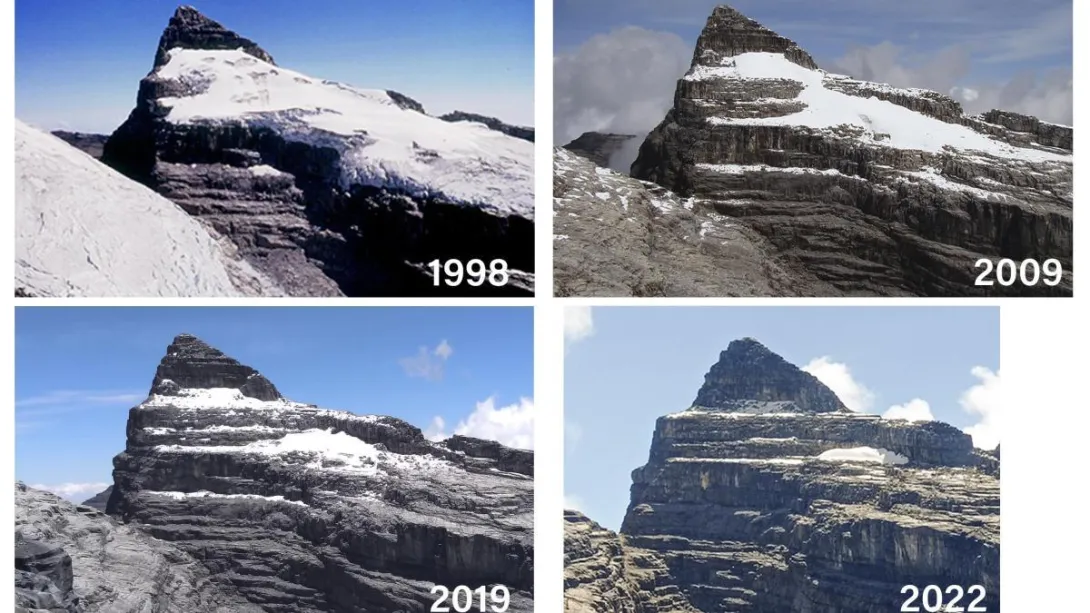Microbial life exists in the wild and cold glaciers of Colombia, according to new research. But many of these ice-phototrophic organisms, unknown to science until a few weeks ago and little studied, could disappear in just a few years due to rising temperatures. This was announced at the Biodiversity Summit (COP16), where the announcement of this discovery was a call for the protection of nature and high mountain ecosystems.
(Lea esta historia en español, aquí)
Photos 9 and 10. Disappearance of the glacier in the Conejeras sector between 2018 (left) and 2024 (right). Author, Ceballos. J. Jorge Luis Ceballos. IdeamThe study, carried out by the Institute of Hydrology, Meteorology and Environmental Studies (Ideam) together with the University of Hokkaido in Japan, the University of Applied Sciences of Upper Austria and the Charles University of the Czech Republic, found that the microbial life of these areas would be the record of biodiversity at the highest altitude in the country. It should be noted that the sampling of snow and ice began in February 2024, in the Santa Isabel glacier and the snowy mountain range of El Cocuy, but it is expected to continue in other places.
According to glaciologist Jorge Luis Ceballos, who presented and led the research, this study shows that glaciers located in the highest areas of the country's mountains can be considered a habitat and part of biodiversity. Among them, unexpected populations of cold-specialized microorganisms have been found, but with the accelerated melting, these unique tropical communities of ice phototrophs would disappear in a few decades.
"Between Ideam and these universities, microbial life has been identified for the first time in Colombian glaciers. These are algae that are adapted to these extreme environments and that seem to be new because of their location in equatorial glaciers. These algae are part of the country's biodiversity and are expanding it," said researcher Ceballos.
Until now, it was not known that the country's biodiversity was also present in the high Colombian mountains, in areas above the páramos. Glaciers are considered natural systems in decline and degraded by the current climate change, but it is little known that they harbor microbial life that is also in danger of disappearing. Similarly, observations from Ideam's regular monitoring have revealed that migratory birds and other high mountain ecosystems temporarily inhabit the glacier surface.
Changes in glacier cover, Conejeras glacier sector, Nevado Santa Isabel. Jorge Luis Ceballos. Ideam"It is a part of our biodiversity that has not yet been recorded, and it is the highest altitude. We have yet to discover new genera of microalgae, to decipher their behavior, but we know that they are different, possibly unique, adapted to the Colombian high mountains, but they are on the way to extinction because their habitat is disappearing," added the expert.
The Institute follows world standards for glacier observation and has been monitoring the glaciers continuously since 2006, like few others in the world. These observations feed into international networks for monitoring the terrestrial cryosphere, which will also be at the heart of next year's environmental debate, as the United Nations General Assembly has agreed to declare 2025 the International Year of Glacier Conservation.
At Ideam, the High Mountain Ecosystems Monitoring Group was created in 2020 in response to the growing importance of mountains in the world because of their biodiversity and the impact of climate change. Unesco, for example, has mentioned that about 75 million people in the Andean region get their water from mountains. In Colombia, 70% of the population gets its water from the mountains.
However, Colombia's glacier area has decreased by 30 percent in the last 12 years. The country went from 47 km² in 2010 to 33 km² in 2022, and the area is shrinking by 3 to 5 percent each year due to rapidly rising temperatures. Given this trend, it is likely that by the end of this century our snow-capped mountains will be extinct or near extinction, representing a loss of the country's environmental heritage. Climatic phenomena such as El Niño are largely responsible for this decline.
EDWIN CAICEDO
Environment and Health Journalist
@CaicedoUcros
Editor's note: This text is an artificially intelligent English translation of the original Spanish version, which can be found here. Any comment, please write to berdav@eltiempo.com
Edwin Caicedo
